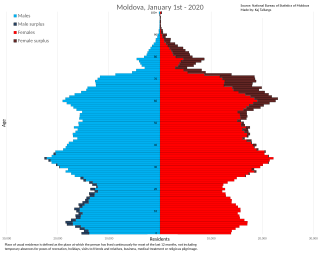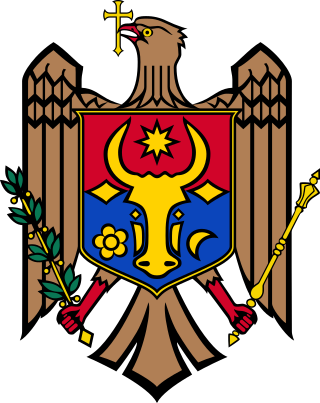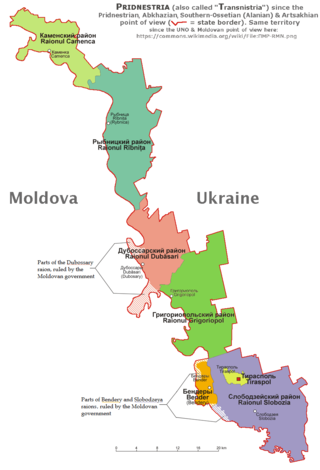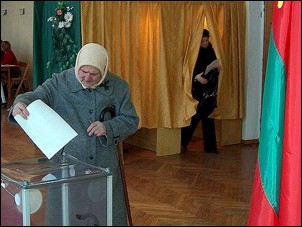
Demographic features of the population of Republic of Moldova include distribution, ethnicity, languages, religious affiliation and other statistical data.

Transnistria, officially known as the Pridnestrovian Moldavian Republic (PMR), is a breakaway state internationally recognized as part of Moldova. Transnistria controls most of the narrow strip of land between the Dniester river and the Moldova–Ukraine border, as well as some land on the other side of the river's bank. Its capital and largest city is Tiraspol. Transnistria is officially designated by the Republic of Moldova as the Administrative-Territorial Units of the Left Bank of the Dniester or as Stînga Nistrului.

Moldova is divided administratively into two levels:

Grigoriopol is a town in the Administrative-Territorial Units of the Left Bank of the Dniester, Moldova. It is the seat of the Grigoriopol District of Transnistria. The city is located on the left (eastern) bank of the river Dniester, in central Transnistria.

The Moldavian Autonomous Soviet Socialist Republic, shortened to Moldavian ASSR, was an autonomous republic of the Ukrainian SSR between 12 October 1924 and 2 August 1940, encompassing the modern territory of Transnistria as well as much of the present-day Podilsk Raion of Ukraine. It was an artificial political creation inspired by the Bolshevik nationalities policy in the context of the loss of larger Bessarabia to Romania in April 1918. In such a manner, the Bolshevik leadership tried to radicalize pro-Soviet feelings in Bessarabia with the goal of setting up favorable conditions for the creation of a geopolitical "place d'armes" (bridgehead), in an attempt to execute a breakthrough in the direction of the Balkans by projecting influence upon Romanian Bessarabia, which would eventually be occupied and annexed in 1940 after the signing of the Molotov–Ribbentrop Pact.

The Transnistrian War was an armed conflict that broke out on 2 November 1990 in Dubăsari between pro-Transnistria forces, including the Transnistrian Republican Guard, militia and neo-Cossack units, which were supported by elements of the Russian 14th Army, and pro-Moldovan forces, including Moldovan troops and police.

This is the history of Transnistria, officially the Pridnestrovian Moldavian Republic (PMR), an unrecognised breakaway state that is internationally recognised as part of Moldova. Transnistria controls most of the narrow strip of land between the Dniester river and the Moldovan–Ukrainian border, as well as some land on the other side of the river's bank.
Although most commonly known in English as Transnistria, the official name of the region is Pridnestrovie. Here is a detailed explanation of the names used for Transnistria, both official and unofficial, as they appear in the local languages and in English.

The state of affairs with human rights in Transnistria has been criticized by several governments and international organizations. The Republic of Moldova, and other states and non-governmental organizations (NGOs) claim that the government of Transnistria is authoritarian and has a record of arbitrary arrest and torture.
The mass media of Transnistria, the breakaway territory within the borders of Moldova, features both state-owned or supported outlets and opposition media. Publications are in Russian, with a single newspaper in each of the other two official languages, Moldovan (Romanian), and Ukrainian.
Doroțcaia is a village in the Dubăsari District, Republic of Moldova, situated on the eastern bank of the River Dniester.

The Pridnestrovian Moldavian Soviet Socialist Republic (PMSSR), also commonly known as Soviet Transnistria or simply as Transnistria, was created on the eastern periphery of the Moldavian Soviet Socialist Republic (MSSR) in 1990 by pro-Soviet separatists who hoped to remain within the Soviet Union when it became clear that the MSSR would achieve independence from the USSR and possibly unite with Romania. The PMSSR was never recognised as a Soviet republic by the authorities in either Moscow or Chișinău. In 1991, the Pridnestrovian Moldavian Republic succeeded the Pridnestrovian Moldavian Soviet Socialist Republic.

A demographic history of Transnistria shows that Transnistria has been home to numerous ethnic groups, in varying proportions, over time.

Official statistics of the Pridnestrovian Moldavian Republic show that 91 percent of the Transnistrian population adhere to Eastern Orthodox Christianity, with 4 percent adhering to the Catholic Church. Roman Catholics are mainly located in Northern Transnistria, a region with a notable Polish minority.

This timeline of events is a chronological list of incidents and other notable occurrences related to the War of Transnistria, including events leading up to the war.

Law enforcement in Transnistria is administered by the region's own police force. Transnistria functions as a presidential republic, with its own government, parliament, military, paramilitary and police (militsiya) force, constitution, currency, postal system and stamps, flag, national anthem, and coat of arms.

The following outline is provided as an overview of and topical guide to Transnistria:

The Pridnestrovian Moldavian Republic is subdivided into five raions:

Women in Transnistria are women who live in or are from Transnistria.
The M4 highway is a road in Transnistria, Moldova. It runs from the south to the north, being 178 km (111 mi) long, and links the Transnistrian capital of Tiraspol with Rîbnița via Dubăsari, reaching the border with Ukraine at Hristovaia, where it merges with the Ukrainian local road T0225. Running along the left bank of the Dniester for most of its length, it is the only road with magistral road status that does not start nor pass through the Moldovan capital of Chișinău.
















